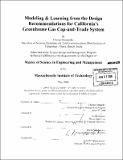Modeling & learning from the design recommendations for California's Greenhouse Gas Cap-and-Trade System
Author(s)
Fernandes, Chester, S.M. Massachusetts Institute of Technology
DownloadFull printable version (50.12Mb)
Alternative title
Modeling and learning from the design recommendations for California's Greenhouse Gas Cap-and-Trade System
Other Contributors
System Design and Management Program.
Advisor
Stefan Spinler.
Terms of use
Metadata
Show full item recordAbstract
Climate Change has become a Major issue beginning with our generation. Governments the world over are now recognizing that industry cannot continue to pollute in a business-as-usual manner. Emitting Greenhouse gases has a global impact, unlike pollutants that are released into soil or water. Global warming created by the Greenhouse effect, amongst other things is causing an increase in the ambient global temperature, causing glaciers to melt and global weather patterns to change. At the same time the world population is increasing, the standard of living for an increasing percentage of the population is improving, and with that the global energy usage is going up and up. Currently, a large portion of the global energy is derived from fossil fuels. Combusting fossil fuels are the primary source of Greenhouse gas emissions. The challenge for governments then is two-fold. One is how to cap and/or reduce the Greenhouse gases from industry, and second, how to achieve this first goal without being detrimental to the industry in a large way, or as some say with the least cost. In the USA, due to lack of a federal standard, several states have either banded together or gone it alone, in defining their own attempt to address the Greenhouse gas problem. The state of California is one such state that has put together a committee of experts, to advise the state on how best to design a system with the two afore-said challenges in mind. A model has been put together to model Option A, Program Design 1 of the California Cap-and-Trade system. (cont.) The goal of the model is to give the regulator an understanding of how by varying the main lever, which is the cap set, the regulator can influence the covered Electric entities in optimally meeting the cap, based on the headroom they have for abatement, and their actual ability to act and the degree to which they can act in abatement; and secondly how this main lever, can create a thriving market for trading allowances, by trying to have almost an equal number of players that want to buy the requisite number of allowances to meet the cap, or sell their excess allowances.
Description
Thesis (S.M.)--Massachusetts Institute of Technology, System Design and Management Program, 2008. Includes bibliographical references (leaf 71).
Date issued
2008Department
System Design and Management Program.Publisher
Massachusetts Institute of Technology
Keywords
System Design and Management Program.